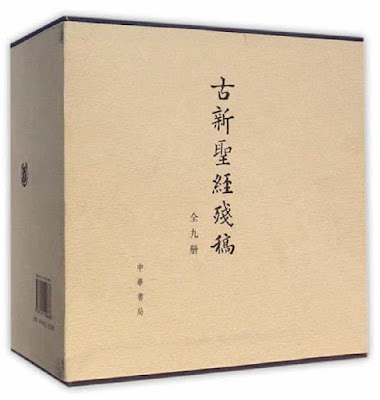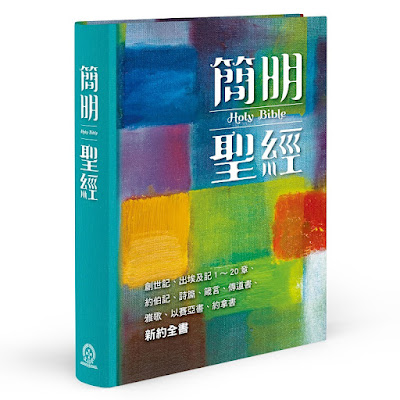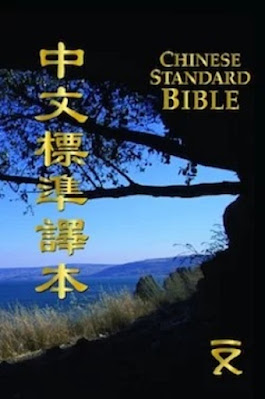07-009
Chinese
Catholic Bible
In the
last few posts, I have introduced different Chinese translations of the
Protestant Bible, from the oldest to the newest. Before I move on to introduce
different Chinese translations of the Catholic Bible, let me spare a few lines
to explain what are the differences between Protestant and Catholic Bible.
What are
the differences between Protestant Bible and Catholic Bible?
The
differences between the Protestant Bible and the Catholic Bible are mainly in
the number and selection of books that each contains. The Protestant Bible has
66 books, while the Catholic Bible has 73 books. The Catholic Bible includes
seven additional books, known as the Deuterocanonical books, that are not found
in the Protestant Bible.
In
Chinese translations, there is another significant difference in between, the
name of people and places. The translations that Catholic churches use are
different from those used by Protestant churches. For example, Mosses is called
摩西 by Protestants but 梅瑟 by Catholics.
Bethlehem is translated as 伯利恆 in Protestant Bible but 白冷 in Catholic Bible. Although the original texts are identical, Catholics
may find difficult to use a Protestant translation.
Therefore,
even though we already got 31 different translations of the Protestant Bible in
vernacular Chinese, Catholic churches would not depend on those Protestant
translations. They need their own translations.
Early
attempts
Translations
of the Catholic Bible in classical Chinese can be dated back to the Yuan
Dynasty, though not much details of those translations were known. Most likely,
only a few scriptures were translated for the use of sermon.
First
record of Bible translation was in early 18th century by Jean Basset.
He finished the translation of the New Testament from Gospel of Matthew
to Epistle to the Hebrews. Since the translation was not completed, it
was never published. But a manuscript is stored in Biblioteca Casanatense. The
British Museum also owns a copy of the manuscript. Although not published,
evidence shows that both early Protestant Bible translators, Robert Morrison
and Joshua Marshman, got inspirations from this translation.
The
next attempt was by François Xavier dʹEntrecolles. In
one of his writing, he included a translation of the Book of Judith in classical
Chinese.
1803 -
Louis Antoine de Poirot's Version (古新聖經)
The
first attempt to translate the Catholic Bible into vernacular Chinese can be
dated back to the early 19th century. Poirot, a Jesuit painter and
translator of the 18th and early 19th century, translated
the Catholic Bible into vernacular Chinese. His translation arrived in 1803,
more than 50 years before the first Protestant vernacular Chinese translation,
which was completed in 1857.
However,
his work was never completed because Poirot could not obtain the permission from
the Holy See. The work was also not published until recently, when scholars
recovered a manuscript from a library in Shanghai.
Works
after Poirot’s
Many
translations appeared in the next 150 years. But most of them were for private
use and never circulated. Only a few of those manuscripts were passed down.
Normally,
only a small portion of the Bible was translated, usually the Four Gospels,
Acts of the Apostle, and sometimes Pauline epistles. Below, I
list out all known vernacular Chinese translations of the Catholic Bible.
1875 –
Wang Duomo, Mandarin Gospels - Acts (王多默聖史宗徒行實)
Little
was known to Rev. Thomas Wang, or Wang Duomo (王多默). A journal from
Lanzhou University states that he was a Catholic priest in Gansu area in the 19th
century. The Catholic churches were under great prosecution during that time
but he kept evangelizing the area in secret.
Wang
Duomo, Mandarin Gospels - Acts only covers the Four Gospels and Acts
of Apostle. But his translation acted as an early resources for local
Catholics to understand the life of their Lord.
This translation was never published. A handwritten copy was passed down and scan images are available on the “Bible Faith Hope & Love Net”. A digitized version is also available for easy reading.
1922 –
Chinese New Testament with study notes by Joseph Hsiao (蕭靜山譯本)
In
1922, the Catholic church finally got their own translation of the Bible
published in vernacular Chinese. But it only contains the New Testament.
Joseph
Hsiao was a Chinese Christian scholar and theologian who translated the New
Testament into vernacular Chinese. Translation of the Four Gospels
completed in 1918. The entire New Testament was published in 1922 as Chinese
New Testament with study notes by Joseph Hsiao. Translation was based on Biblia
Vulgata. Hsiao is considered one of the pioneers of the Chinese Bible
translation movement.
The translation was reprinted several times in later years. It is available on Bible app YouVersion.
1939 –
Hsiao Shun-hua, Mandarin Gospels-Acts & Prison Epistles with study notes (蕭舜華官話)
From
1939 to 1943, Rev. Hsiao Shun-hua successively translated and published four
separate volumes of the Gospels in Mandarin, followed by the Acts of the
Apostles in 1941 and the Pauline Epistles in 1943. His translation
stopped at The Epistle to Philemon, as Hsiao was involved in next translation
work.
Hsiao Shun-hua, Mandarin Gospels-Acts & Prison Epistles with study notes can be read on the “Bible Faith Hope & Love Net”. The Four Gospels and Acts of the Apostles were digitized. Only scan images of the Pauline Epistles are available and some pages are missing.
1949 –
Chinese New Testament with study notes by Litványi and others (新經全書)
In
1949, Jesuit priests György Litványi, René Archen, Édouard Petit and Hsiao Shun-hua
jointly translated and published the Chinese New Testament with study notes
by Litványi and others. Litványi was the chairman of the editorial
committee. Compared with the earlier translation by Joseph Hsiao, which also
translated the Greek original text into Mandarin, Joseph’s translation is
smooth and concise, while Litványi tries to preserve the Greek style, emphasizing
the beauty of the writing more than the fidelity. Both translations have study
notes, but study notes in Litványi’s translation are not as many as those in
Joseph Hsiao’s.
Litványi translated and published the Gospels in 1940 and the entire New Testament in 1949. Acts of the Apostles and Romans were also published in separate volumes from 1955 to 1956. This translation is now available on Bible app YouVersion.
1953 -
The Four Gospels (新譯福音初稿)
The
Four Gospels were retranslated by The Shanghai Jesuit Xu Hui
General Seminary (上海耶穌會徐匯總修院) and published
by the Shanghai Tushanwan Printing Press (上海土山灣印書館). First publishing
date of this translation was uncertain. Wikipedia said 1948. Other sources said
1953 or 1954. But according to the scan images on the “Bible Faith Hope &
Love Net”, publishing date is more likely to be 1953.
In the
preface of The Four Gospels, the translation committee explained the
reason of the translation.
“The Gospels have been widely circulated and translated into many versions. Among the famous Catholic translations in China, there are: Li Wenyu’s translation of the New Testament and Interpretation of the Scriptures, Ma Xiangbo’s Gospels, and John Wu Ching-hsiung’s translation of the New Testament. Unfortunately, they are all written in classical Chinese and are not suitable for general readers.There are also various translations in vernacular Chinese, among which the more popular ones are the Chinese New Testament with study notes by Joseph Hsiao, and the Chinese New Testament with study notes by Litványi and others. However, Hsiao’s version has a lot of local dialects and is inevitably vulgar, while Litványi’s version has a more fluent and elegant text, but sometimes deviates from the original text. Neither of them is the ideal translation that modern faithful expect. Therefore, it is an urgent task to publish an ideal translation: a translation that is simple but not vulgar, accurate but not awkward, and beautiful but not embellished.”
Scan images and digitized version of The Four Gospels can be found on the
“Bible Faith Hope & Love Net”.
1968 -
Studium Biblicum Version (思高本)
In 1968,
we finally see a translation of the entire Catholic Bible in Chinese language.
The Studium Biblicum Version is the predominant Chinese language
translation of the Bible used by Chinese Catholics. It is considered by many to
be “the Chinese Catholic Bible”.
The Studium
Biblicum Version was translated by the Studium Biblicum Franciscanum in
Hong Kong (a bible society not affiliated with the United Bible Societies).
Translation originally started in 1935 as a personal effort by a Franciscan
Friar, the Blessed Gabriele Allegra, but translation work was halted due to
World War II, and part of the finished translations were lost due to the war.
The bible society was formed in 1945 when more translators joined the
translation work, and the whole bible was completed in 1968.
The
translation of the Old Testament was based on Biblia Hebraica Kittel (3rd
ed.), with Septuagint influence. New Testament was based on Augustinus
Merk. Novum Testamentum: Graece et Latine. (7th ed.) and Deuterocanonical
books on Septuagint (H. B. Swete) and Vulgate (Mons. L. Grammatica).
Hard copy of the Studium Biblicum Version can be found in Catholic bookstores. Digital copy can be read on the official website of the publisher or through mobile app ccReadBible (iOS / Android).
1994 -
The New Testament - A New Translation (新經全集 - 新譯本)
Starting from 1983, under the leadership of Bishop Jin Luxian,
the Catholic Diocese of Shanghai in China translated the New Testament based on
the Jerusalem Bible (La Bible de Jérusalem), The Four Gospels (1953) translated
by The
Shanghai Jesuit Xu Hui General Seminary, and other
Chinese Bible translations.
In 1986, the Diocese of Shanghai published The Four Gospels.
Then, it successively published The Acts of the Apostles, The Commentary
on The Acts of the Apostles, The Pauline Epistles, The General
Epistles and Revelation, etc. After more than ten years of hard
work, in August 1994, the Diocese of Shanghai completed the translation of the New
Testament and published the The New Testament - A New Translation in one
volume. A revised version is published in 2004. Translation of the Old
Testament is still under progress.
Hard copy of the Bible can be brought from some Christian bookstores. And I am still finding the soft copy of this translation.
1999 -
Pastoral Bible (牧靈聖經)
The
Chinese Pastoral Bible is the Chinese edition of the Christian
Community Bible. Work on the translation began in 1991, took 5 years to
finish, and the completed translation was published in 1999. This is the second
Chinese translation of the entire Catholic Bible.
The
main translation work was done in the Philippines and Taipei, but the
publication and distribution of the simplified version were done in mainland China.
The publishers that support this version are San Pablo Internacional, operated
by the Societas a Sancto Paulo Apostolo, in Spain and Claretian Publication, operated
by the Cordis Mariae Filius, in Macau.
The Chinese Pastoral Bible can be read on the official website: https://pbible.org/bible/
2014 -
Claretian New Testament (樂仁譯本)
The Claretian
New Testament Bible is a Chinese Bible featured with “dynamic-equivalent”
translation. Claretian Publications is one of pastoral service provided by the
Claretian Missionary Congregation.
The
translation came with Commentary and Lectio Divina, a traditional Christian practice
of scriptural reading through four steps of “lectio”, “meditation”, “oratio”
and “action” to listen to and to imitate the Word of God.
The Claretian
New Testament Bible was published in 2014. Translation of the Old Testament
was also completed. Wisdom Books were published in August, 2023 and other
books will be published soon. Once completed, this will be the third Chinese
translation of the entire Catholic Bible.
Hard copy of The Claretian New Testament Bible is available on Catholic bookstores. Soft copy of the translation is available to download from Catholic on line (天主教在線).
Direct link: https://dl.ziliaozhan.win/%E4%B9%A6%E7%B1%8D/pdf/%E5%9C%A3%E7%BB%8F/
Summary
Compare
to 31 vernacular Chinese translations of the Protestant Bible, translations of
the Catholic Bible come in a much smaller number. At the time of writing, there
are only 10 vernacular Chinese translations of the Catholic Bible. And only 2 translations
covered the entire Catholic Bible, with 2 more translations of the Old
Testament under progress.
However,
if we add everything up, then there are altogether 41 different translations of
the Bible in vernacular Chinese, and 20 of them covers the entire Bible. This
is really quite good.
Before
I move on to talk about difference Chinese translations of the Orthodox Bible,
I would like to make a detour to talk about apocrypha first. To understand the
structure of Orthodox Bible, some knowledges on apocrypha is essential.
Go back to the Lobby ...
























